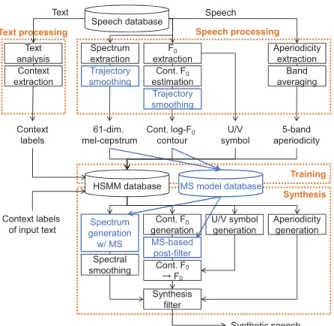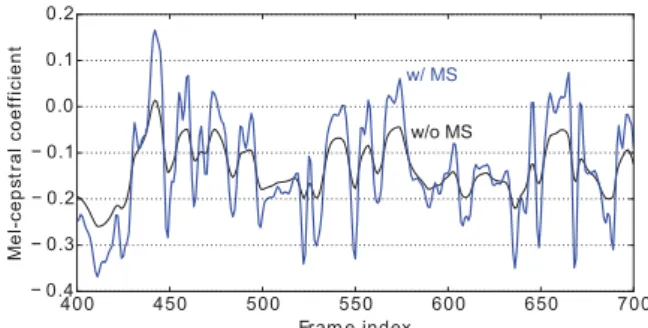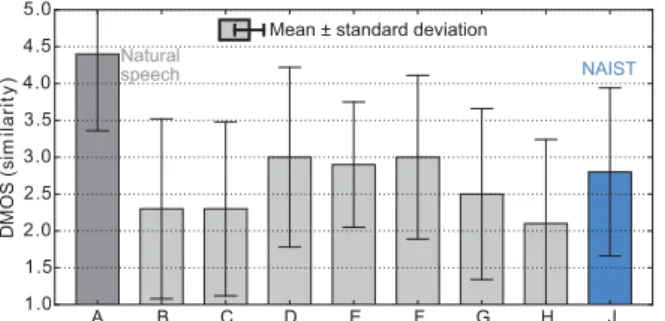The NAIST Text-to-Speech System for the Blizzard Challenge 2015
Shinnosuke Takamichi
1, Kazuhiro Kobayashi
1, Kou Tanaka
1, Tomoki Toda
1,2, Satoshi Nakamura
11
Graduate School of Information Science, Nara Institute of Science and Technology, Japan
2
Information Technology Center, Nagoya University, Japan
{ shinnosuke-t, kazuhiro-k, ko-t, s-nakamura } @is.naist.jp, tomoki@icts.nagoya-u.ac.jp
Abstract
This paper presents a text-to-speech (TTS) system developed at Nara Institute of Science and Technology (NAIST) for the Bliz- zard Challenge 2015. The tasks of this year’s challenge are the mono-lingual speech synthesis (IH1 hub task) for 6 Indian lan- guages including Bengali, Hindi, Malayalam, Marathi, Tamil, and Telugu, and the multi-lingual speech synthesis (IH2 spoke task) for Indian language and English. We have developed our TTS system based on a statistical parametric speech synthe- sis technique using a hidden Markov model (HMM). To im- prove quality of synthetic speech, we have newly implemented two techniques for the traditional HMM-based speech synthe- sis framework, 1) pre-processing for producing smooth param- eter trajectories to be modeled with HMM and 2) speech pa- rameter generation considering the modulation spectrum. The developed system has been submitted to the mono-lingual task and its performance has been demonstrated from the results of large-scaled subjective evaluation.
Index Terms: HMM-based speech synthesis, modulation spec- trum, parameter trajectory smoothing, continuous F
0contour, speech parameter generation
1. Introduction
In order to better understand different speech synthesis tech- niques to develop a corpus-based text-to-speech (TTS) system using a common dataset, Blizzard Challenge was devised in January 2005 [1] and has been held every year since then [2].
This year’s Blizzard Challenge has two tasks, 1) a mono-lingual speech synthesis task (IH1 hub task) for 6 Indian languages con- sisting of Bengali, Hindi, Malayalam, Marathi, Tamil, and Tel- ugu, and 2) a multi-lingual speech synthesis task (IH2 spoke task) for Indian language and English. The Indian datasets [3]
provided in the challenge consist of speech waveforms and the corresponding texts only. The size of the speech data in each In- dian language is about 4 hours for Hindi, Tamil and Telugu, and 2 hours for Bengali, Malayalam, and Marathi. They are sam- pled at 16 kHz. The text data is provided in UTF-8 format. As only the plain text data is provided without any additional infor- mation, such as a phoneme set, syllable definition, and prosodic labels, participants need to develop a natural language process- ing module (front-end) as well as a speech waveform generation module (back-end) to develop their own TTS systems.
Our research group, a speech synthesis group of Aug- mented Human Communication laboratory, Nara Institute of Science and Technology (NAIST), studies various speech syn- thesis techniques, such as high-quality statistical paramet- ric speech synthesis techniques [4], real-time voice conver- sion techniques for augmented speech production [5] (e.g., voice/vocal effector [6] or a speaking aid system for laryngec- tomees [7]), towards the development of technologies to break
down existing barriers in our speech communication. To sub- mit a TTS system from our group to the Blizzard Challenge 2015, we have developed our own system, the NAIST TTS sys- tem based on a statistical parametric speech synthesis technique using hidden Markov model (HMM) [8]. To improve quality of synthetic speech, two techniques are newly implemented for the traditional HMM-based speech synthesis framework, 1) pre- processing for producing smooth parameter trajectories to be modeled with HMM and 2) speech parameter generation con- sidering the modulation spectrum (MS) of speech parameters [9, 10]. The developed system has been submitted to the mono- lingual task and its performance has been demonstrated from the results of large-scaled subjective evaluations.
This paper describes details of the NAIST TTS system. We also briefly discuss the results of large-scaled subjective eval- uations on naturalness, similarity to the original speaker, and intelligibility, which were provided from the organizers.
2. The NAIST HMM-based TTS system for mono-lingual task
The NAIST TTS system has 4 main modules; a text processing module, a speech processing module, a training module, and a speech synthesis module, as shown in Fig. 1. Context labels used for HMM training are generated using the existing toolkit or our developed rule-based grapheme-to-phoneme converter and syllable estimator in the text processing module. Smoothly varying speech parameter sequences are extracted in the speech processing module. The context-dependent phoneme HMMs and the MS probability density functions are trained using the context labels and the speech parameters in the training mod- ule. Finally, a speech waveform is generated from these trained models corresponding to a given text to be synthesized in the synthesis module.
2.1. Text processing module 2.1.1. Text analysis
Because the provided Indian datasets do not include any lin- guistic information, such as a phoneme set and prosodic labels, which is usually needed to describe speech parameters corre- sponding to a given text, it is indispensable to predict these in- formation from the given text. In the last year’s challenge, some participants used several techniques to cope with this issue, e.g., the use of an existing speech recognizer for a different language to extract auxiliary linguistic information [11] or the develop- ment of a fully data-driven text analyzer [12].
In this year’s challenge, we used hand-crafted text analyz-
ers. We used text analyzers developed with language-specific
recipes distributed by Festvox [13] for Bengali, Hindi, Tamil,
and Telugu. Additionally, we also developed a text analyzer for
!
"
"#
$
%
"#
!
!
&'
"
(')
(')
Figure 1: An overview of the NAIST TTS system for the Bliz- zard Challenge 2015. The orange-colored boxes indicate 4 main modules, a text processing module, a speech processing module, a training module, and a synthesis module. The blue- colored items are techniques newly implemented for the tradi- tional HMM-based speech synthesis framework to improve syn- thetic speech quality, where “cont. F
0” and “MS” indicate the continuous F
0and the modulation spectrum, respectively.
Marathi with the recipe for Hindi because Marathi has a certain similarity to Hindi. For Malayalam, we developed a rule-based grapheme-to-phoneme converter [14] dealing with chillus and a rule-based syllable estimator considering specific characteris- tics of Malayalam, such as dependent vowel signs.
2.1.2. Context label generation
The context labels are required to train the context-dependent phoneme HMMs. Our context labels were designed on the basis of the contextual factors used in HTS speaker adapta- tion/adaptive training demo for English [15]. An example of the contextual factors used in our context label definition is shown as follows:
• phoneme, syllable structure, and stress
• vowel/consonant, articulator position, and voic- ing/unvoicing
• position of phoneme, syllable, and word
• the number of phonemes, syllables, and words.
Note that stress information is not used for Malayalam because it is not extracted in our text analysis module.
2.2. Speech analysis module 2.2.1. Speech feature extraction
A high-quality speech analysis-synthesis system is required to develop a high-quality TTS synthesizer. We conducted prelimi- nary evaluation to compare analysis-synthesized speech quality by STRAIGHT [16, 17] and WORLD [18, 19] as a high-quality analysis-synthesis system. From the result of this preliminary
Figure 2: An example of the 20-th mel-cepstral coefficient se- quences before and after the low pass filtering that removes the MS components over than 50 Hz. We can see that some fluctu- ations have been removed.
evaluation, we decided that spectral envelope and aperiodic- ity were extracted with STRAIGHT, given F
0extracted with WORLD. They were parameterized into the 0 th -through- 60 th mel-cepstral coefficients, band aperiodicity, and log-scaled F
0, where the band aperiodicity was calculated by averaging aperi- odicity of each frequency component in 5 frequency bands [20].
The shift length was set to 5 ms. Moreover, the continuous F
0contour [21] was additionally produced from the extracted F
0contour. The spline-based interpolation algorithm was used to estimate F
0values at unvoiced regions [9].
2.2.2. Parameter trajectory smoothing
Many fluctuations are usually observed over a time sequence of some speech parameters, such as mel-cepstral coefficients.
They are represented as the MS of the temporal parameter se- quence, i.e., power spectrum of the parameter sequence. As described in [9], we have found that the effect of the MS com- ponents in high MS frequency bands on quality of analysis- synthesized speech is negligible, e.g., more than 50 Hz MS fre- quency components for the mel-cepstral coefficient sequence and more than 10 Hz MS frequency components for the con- tinuous F
0contour.
1To make the HMMs focus on the model- ing of only auditory informal components, low-pass filter (LPF) was applied to each parameter sequence. The cutoff frequency of LPF was set to 50 Hz for the mel-cepstral coefficients and 10 Hz for the continuous F
0contour, respectively. An exam- ple of this parameter trajectory smoothing for the mel-cepstral coefficients is shown in Fig. 2.
2.3. Training module
2.3.1. Hidden semi-Markov model training
The context-dependent phoneme hidden semi-Markov models (HSMMs) were trained on the basis of a maximum likelihood criterion in a unified framework to model individual speech components [23]. Five-state left-to-right HSMMs were used for every Indian language. The feature vector consisted of mel- cepstral coefficients (61 dimensions), continuous log-scaled F
0contour (1 dimension), band aperiodicity (5 dimensions), and their delta and delta-delta features, and discrete log-scaled F
0contour (1 dimension) consisting of unvoiced symbols. The to- tal dimensionality of the feature vector is 202. Only for Hindi, we used the 0 th -through- 24 th mel-cepstral coefficients as we found that the spectral parameter because the 61-dimentional
1
Micro-prosody is captured by these components [22].
Table 1: Number of training utterances for each language. No external data was used.
Bengali Marathi Hindi Tamil Malayalam Telugu
1304 1197 1709 1462 1289 2481
mel-cepstral coefficients were not well modeled in the HSMMs.
The spectrum, continuous F
0, band aperiodicity components were modeled with the multi-stream continuous distributions.
The discrete F
0contour was additionally modeled with the multi-space distributions [24] to determine the voiced/unvoiced region of the continuous F
0contour in the synthesis module.
The tree-based clustering with the minimum description length (MDL) criterion [25] was employed. The stream weights were set to 1.0 (spectrum), 1.0 (continuous F
0), 1.0 (discrete F
0)
2, and 0.0 (aperiodicity). The number of utterances included in training data is listed in Table 1.
2.3.2. MS model training
Gaussian distributions were also trained as the context- independent MS models for the spectrum and continuous F
0contour. The utterance-level mean was first subtracted from the temporal parameter sequence, and then its MS was calculated.
The length of discrete Fourier transform to calculate the MS was set to cover the maximum utterance length of the training data. These MS models were used in the synthesis module to reproduce the MS components, which were not well reproduced from the HSMMs only.
2.4. Synthesis module
2.4.1. Speech parameter generation
In the synthesis module, the context labels were first gen- erated in the text processing module, and then the sentence HSMM corresponding to the text to be synthesized were con- structed to generate the spectrum, continuous F
0, aperiodic- ity, and voiced/unvoiced regions. The spectral parameters were generated based on the speech parameter generation algorithm considering the MS components lower than 50 Hz [10]. The other parameters were generated based on the ML-based pa- rameter generation [27]. Additionally, we applied the MS-based post-filter [9] to the generated continuous F
0contour.
3The MS was not considered in the aperiodicity component because there was no quality gain by the MS modification. An example of the generated mel-cepstrum sequences is illustrated in Fig. 3. We can find that more fluctuations are observed on the mel-cepstal sequence generated with the MS than that without the MS. Note that the global variance (GV) [28] is also recovered because the MS can also represent the GV.
2.4.2. Spectral smoothing in silence frames
After speech parameter generation, we further performed spec- tral parameter smoothing at silence frames. The averaged spec- tral parameter at a current silence region was calculated and the spectral parameters in the silence region were replaced with the averaged one.
2
This stream setting is similar to the duplicated feature training [26]
and the stream weights for continuous
F0and discrete
F0should be determined. We informally evaluated synthetic speech quality using some stream weight settings and chose this setting.
3
No significant quality difference was observed between the contin- uous
F0contour generated by speech parameter generation considering the MS and that filtered by the MS-based post-filter.
Figure 3: An example of the 20-th mel-cepstral coefficient se- quence generated without considering the MS [27] (“w/o MS”) and that with considering the MS (“w/ MS”).
!""#
$%&' $()
Figure 4: Result of MOS test on naturalness in Marathi.
3. Experimental results
To submit the NAIST TTS system to the Blizzard Challenge 2015, we synthesized 50 reading texts (RD) and 50 semantically unpredictable sentences (SUS) in each language. The following 3 subjective evaluations were conducted in the challenge: (1) a mean opinion score (MOS) test on naturalness, (2) a degra- dation MOS (DMOS) test on similarity to the original speaker, and (3) a manual dictation test on intelligibility to calculate the word error rate (WER).
Because of the limited space, we only show the results of the naturalness evaluation using RD sentences (Fig. 4), the sim- ilarity evaluation using RD sentences (Fig. 5), and the intelligi- bility evaluation (Fig. 6) in Marathi. Alphabets “A” and “J” in- dicate natural speech and our system, respectively. The other al- phabets indicate the other participants’ systems. We have found that our system was ranked in the highest group among the sub- mitted systems in terms of naturalness in most of Indian lan- guages but the gap between natural speech and synthetic speech was still large. Although our system was evaluated as the best in terms of intelligibility in Marathi (which was better than nat- ural speech), such a result was not observed consistently over the other languages. Finally, our system was usually ranked in the middle group among the submitted systems in terms of sim- ilarity.
4. Summary
This paper has presented the NAIST TTS system for the Bliz- zard Challenge 2015. The pre-processing for smoothing param- eter trajectories and the speech parameter generation consid- ering the modulation spectrum have been implemented in our system. The results in the challenge have demonstrated that our system is capable of synthesizing naturally sounding speech.
Acknowledgements:
Part of this work was supported by JSPS
KAKENHI Grant Number
26280060, Grant-in-Aid for JSPS Fellows
Grant Number
26·10354, and “JSPS Strategic Young Researcher Over-
! """#$
%&
'() %*+
Figure 5: Result of MOS test on similarity to the original speaker in Marathi.
!
"#$
%&'
"()*


